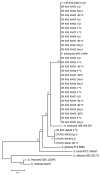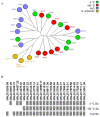Preservation Methods in Isolates of Sporothrix Characterized by Polyphasic Approach
- PMID: 36675855
- PMCID: PMC9865284
- DOI: 10.3390/jof9010034
Preservation Methods in Isolates of Sporothrix Characterized by Polyphasic Approach
Abstract
Sporotrichosis is a subcutaneous mycosis with worldwide distribution and caused by eight pathogenic species of the Sporothrix genus. Different ex situ preservation methods are used around the world to maintain the survival, morphophysiological and genetic traits of fungal strains isolated from patients with sporotrichosis for long terms. The main aim of the present study was to evaluate the survival, phenotypic and genotypic stability of Sporothrix strains after preservation on PDA slant stored at 4 °C, sterile water and cryopreservation at -80 °C, for a period of time of 6, 12, 18 and 24 months of storage. Eight clinical Sporothrix isolates were identified based on a polyphasic approach consisting of classical macro- and micro-morphological traits, biochemical assays, proteomic profiles by MALDI-TOF MS and molecular biology. According to the final identification, one strain was identified as S. schenckii (CMRVS 40428) and seven strains were re-identified as S. brasiliensis (CMRVS 40421, CMRVS 40423, CMRVS 40424, CMRVS 40425, CMRVS 40426, CMRVS 40427 and CMRVS 40433). In addition, it was observed that the isolates survived after the different time points of storage in distilled water, PDA slant and cryopreservation at -80 °C. For fungi preserved in water, low polymorphisms were detected by the partial sequencing of β-tubulin. Cryopreservation at -80 °C induced morphological changes in one single isolate. The proteomic profiles obtained by MALDI-TOF MS after preservation showed differences among the methods. In conclusion, preservation on agar slant stored at 4 °C was the most effective method to preserve the eight clinical Sporothrix strains. This method produced less change in the phenotypic traits and kept the genetic integrity of all strains. Agar slant stored at 4 °C is a simple and inexpensive method and can be especially used in culture collections of limited funding and resources.
Keywords: Sporothrix; genotype; phenotype; preservation; proteomic; stability.
Conflict of interest statement
The authors declare no conflict of interest.
Figures




Similar articles
-
Molecular and phenotypic reidentification of Sporothrix schenckii clinical isolates preserved under mineral oil for 34 to 64 years in a culture collection in Brazil.Curr Res Microb Sci. 2022 Mar 24;3:100128. doi: 10.1016/j.crmicr.2022.100128. eCollection 2022. Curr Res Microb Sci. 2022. PMID: 35909610 Free PMC article.
-
Canine sporotrichosis: polyphasic taxonomy and antifungal susceptibility profiles of Sporothrix species in an endemic area in Brazil.Braz J Microbiol. 2021 Mar;52(1):135-143. doi: 10.1007/s42770-020-00328-8. Epub 2020 Jul 2. Braz J Microbiol. 2021. PMID: 32617836 Free PMC article.
-
Feline sporotrichosis caused by Sporothrix schenckii sensu stricto in Southern Thailand: phenotypic characterization, molecular identification, and antifungal susceptibility.Med Mycol. 2022 Sep 30;60(9):myac075. doi: 10.1093/mmy/myac075. Med Mycol. 2022. PMID: 36130102
-
Global distribution of animal sporotrichosis: A systematic review of Sporothrix sp. identified using molecular tools.Curr Res Microb Sci. 2022 May 19;3:100140. doi: 10.1016/j.crmicr.2022.100140. eCollection 2022. Curr Res Microb Sci. 2022. PMID: 35909607 Free PMC article. Review.
-
Molecular identification of the Sporothrix schenckii complex.Rev Iberoam Micol. 2014 Jan-Mar;31(1):2-6. doi: 10.1016/j.riam.2013.09.008. Epub 2013 Nov 19. Rev Iberoam Micol. 2014. PMID: 24270070 Review.
Cited by
-
MALDI-TOF MS: A Quick Method to Detect the Susceptibility of Fusarium spp. Clinical Isolates to Amphotericin B.Microorganisms. 2023 Jul 18;11(7):1834. doi: 10.3390/microorganisms11071834. Microorganisms. 2023. PMID: 37513006 Free PMC article.
References
-
- Rodrigues A.M., Cruz-Choappa R., Fernandes G.F., de Hoog G.S., de Camargo Z.P. Sporothrix chilensis sp. nov. (Ascomycota: Ophiostomatales), a soil-borne agent of human sporotrichosis with mild-pathogenic potential to mammals. Fungal Biol. 2016;120:246–264. doi: 10.1016/j.funbio.2015.05.006. - DOI - PubMed
LinkOut - more resources
Full Text Sources
Miscellaneous

